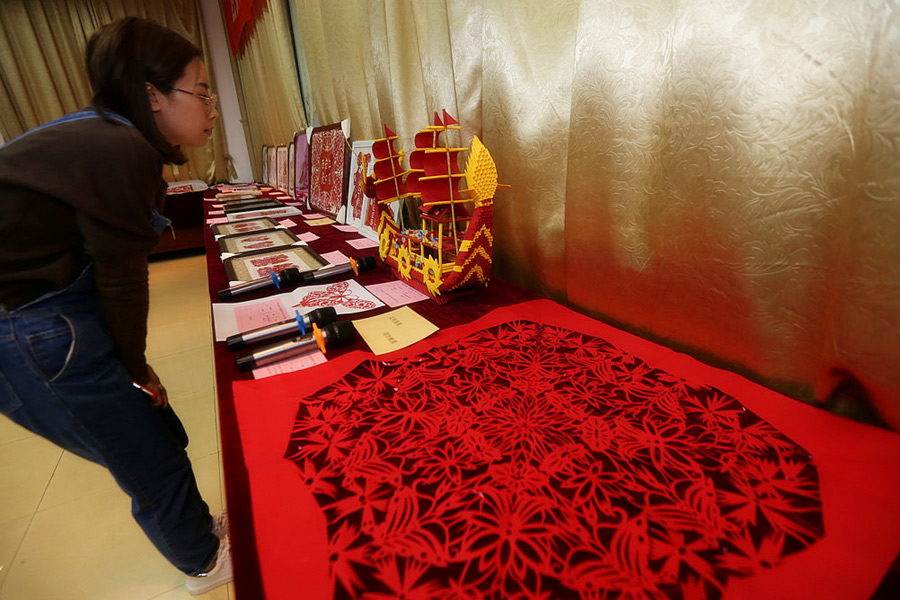
A waist-drum dance is performed during a show staged in Ansai district, Yan'an, Shaanxi. [Photo provided to China Daily]
Construction worker Jiang Hongfei, 33, is a part-time waist-drum performer, playing the instrument as it hangs from a sash around his middle.
Jiang's hometown of Fengjiaying village, Ansai district in Yan'an city, Shaanxi province, is known for its long history of waist-drum dances. Of the 2,275 residents, 246 are professional waist-drum performers of different ages.
Like many of his peers, Jiang taught himself to play the instrument as a child. Last year, he joined a training program organized by the government to brush up on his skills.
The waist-drum dance is a group performance of great momentum that can last as long as 10 minutes or more. Jiang earns 100 yuan ($15.63) for each performance.
The income is unstable as the process is akin to taking odd jobs, and everything depends on the availability of work.
"I can supplement my family income with the waist-drum dance. It's laborious working at construction sites. I only go to them when I have no waist-drum performances," said Jiang, who lifted himself out of poverty last year.
In 2019, he stayed in Beijing for several months to perform the waist-drum dance.
Last year, China achieved its goal of eradicating abject poverty. Ansai is a perfect example of how poverty can be alleviated via the promotion of intangible cultural heritage because the district is famous for its waist-drum dance, paper-cutting activities, folk songs, painting and a form of folk art called quyi.
The district government has organized regular training sessions for those living in poverty, hoping that professional skills will make it easier for them to make a living. Impoverished people also receive subsidies if they attend classes. Like many of his peers, Jiang has benefited from such policies.
In March 2018, as part of a plan to develop local tourism, the Ansai government invested over 18 million yuan to transform Fengjiaying into the "Waist Drum Culture Village".
The program offered the village's poverty-stricken people job opportunities and converted their land into shares in a newly established management company, ensuring an annual dividend of at least 1,500 yuan each.
It also established training centers in Fengjiaying that provided impoverished people with free classes in playing the waist drum, singing folk songs and paper-cutting skills.
Fengjiaying organizes regular waist-drum dances for tourists. The performers are hired according to ability; if their skills are inadequate, they can seek help from the teachers so they will improve and eventually be hired.

Yang Baoping carves a wood sculpture in Zhongnanshan village, Northwest China's Shaanxi province. [Photo/english.cctv.com]
Official data show that in 2019, the per capita income of people officially designated as impoverished in the village was over 11,767 yuan, 15.48 percent of which was generated by poverty alleviation efforts in the cultural field.
"I'm pleased to witness the great changes in the village and see that things are getting better and better," said Gao Yuanyuan, 30, a village cadre. In 2012, the recent college graduate became an official in Fengjiaying, and she chose to continue when her six-year tenure ended.
She has good relations with the villagers and visits impoverished families regularly to help and encourage them.
"As their financial condition has improved, they have become refreshed and energetic," she said.
The COVID-19 outbreak affected the domestic tourism industry, but Fengjiaying is currently recovering. The village received more than 20,000 tourists during the three-day Labor Day holiday this year.
Gao hopes that greater cooperation with travel agencies will bring more visitors, which will mean higher incomes for waist-drum performers.
Zhou Zhisai, 47, a veteran performer from Fengjiaying, is one of the volunteer teachers at the government-organized training sessions.
"I learned how to play the waist drum on my own by watching other people perform. I'm proud that I can pass on the skills to others who are eager to learn," he said.
Many of his students are younger than 40 because the folk activity is highly physical and requires a strong constitution.
He said a student can master the basics after 15 days of training, and it doesn't take long before they are able to perform on stage if they devote themselves to practice. A general waist-drum performer can earn more than 3,000 yuan per month.
In 2016, Zhou established a small company that offers waist-drum dances. Some of the performers come from low-income families, and their busiest season is the first lunar month, when Spring Festival is celebrated.
The waist-drum dance was once a male-dominated activity, but more women have become professional performers, including Zhou's wife.
"It's the best form of general exercise. You can build up a good physique and improve your health," Zhou said, adding that he became interested in the art form when he was 8. Like many of his fellow villagers, he sees it not only as a hobby, but also as a good way to earn a living.
"Market demand for the waist-drum dance is higher than before. We're often invited to perform at the openings of new companies or at cultural activities," he said.
He attributed its growing popularity to the renown of Ansai's waist-drum dancers and to the fact that people enjoy the lively performances.

Handicraft works created by staff of public works departments are exhibited in Xi'an, Northwest China's Shaanxi province, on Mar 5, 2018. [Photo/IC]
Paper-cutting classes
Yu Zeling, 55, a master of traditional paper-cutting craft, is also a volunteer teacher at the government's free training sessions.
"Skill comes from practice. When the 15 days of training come to an end, those who really like paper-cutting will practice on their own, and they often come to my home to ask me questions," she said.
One of her students is a talented 18-year-old woman with hearing and speaking impairments. As the woman comes from a low-income family, Yu has taught her free of charge for two years.
"The local government offers a cash bonus if you win a prize in a paper-cutting contest, either at city or provincial level. Such an incentive is a great encouragement for those learning the art," she said.
The Women's Handicraft Association in Ansai also offers free training in skills such as paper-cutting, embroidery and painting. After being trained, people from impoverished families can find jobs at a cooperative owned by the association's members.
Chen Lianlian, the association's 37-year-old president, is adept at paper-cutting. She noted that many women like to learn the skill, which is easier to master than some other handicrafts.
Those who are good with their hands can make simple paper-cuts for customers after about a month's training, earning an average monthly wage of about 1,000 to 2,000 yuan based on the quantity and quality of their work.
Customers come from all over the country and the paper-cuts are used on special occasions or sold to tourists as souvenirs.
To recruit people with talent, Chen often contacts those who have already received training to ask if they wish to improve their skills at the association's workshops and gain a better opportunity to secure a job.
She said many impoverished students are 40-something women with a low level of education and no special skills, but some even become their family's major breadwinner.
"You don't have to keep office hours. You can do the work at home, any time you like. It's a good part-time job to earn more for one's family. It's also convenient for those who have to look after children or the elderly," she said.
"However, it's a tedious job and not very profitable, and you have to sit still for hours. For the good of one's health, especially one's eyesight, it's better to only do it part time."
She said the national training policy has greatly promoted China's intangible cultural heritage, including paper-cutting.
She hoped that more professionals will soon be available to train paper-cutting tutors and better spread the art form across the country.

